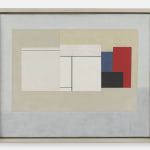Ben Nicholson 1894-1982
1942 (H.S.), 1942
oil on canvas stretched over panel
19 1/4 x 24 1/8 inches
48.9 x 61 cm
48.9 x 61 cm
signed and dated on the reverse
Further images
Ben Nicholson painted 1942 (H.S.) in the midst of the World War II, three years after he had left London with Barbara Hepworth and their three children for the safety...
Ben Nicholson painted 1942 (H.S.) in the midst of the World War II, three years after he had left London with Barbara Hepworth and their three children for the safety of Carbis Bay. In Cornwall, far from the vibrant avant-garde artistic hub of Hampstead, Nicholson continued to produce work and promote his Constructivist ideas with ardent enthusiasm.
In 1942 (H.S.), one large rectangular form, roughly in the centre of the composition, floats with a precise and emphatic flatness against two horizontal bands that gradate upwards from silvery grey to pale blue. On closer inspection, this central rectangle reveals itself to be composed of two forms in slightly different tones of a muted brownish grey. Within these, five smaller geometric forms exist – a grey and a white form, divided up further by black lines, and a section of three overlapping rectangles in red, blue and black.
With its interlocking planes, bold use of line and geometric facets of unmodulated intense colour, 1942 (H.S.) harks to the work of Piet Mondrian, who Nicholson had met in Paris in 1934 and forged a close friendship with. It was Nicholson that aided the artist’s move from Paris to Hampstead, in 1938, setting him up in a flat on Parkhill Road that backed onto Mall Studios, where he and Hepworth lived and worked. Working in close proximity from 1938 – 1939, there was a passionate exchange of ideas between the artists, the result of which is borne out in the present work. However, while there are strong affinities between Nicholson and Mondrian’s approach to abstraction in this period, in comparison to Mondrian, who, up until 1940 1 worked strictly within the parameters of primary-coloured geometric forms within a grid of black vertical and horizontal lines on a white ground, Nicholson experimented more freely with his abstract designs, employing a wider array of colours and subtler tones, which often refer obliquely to the landscape.
Aside from the small, coloured element, 1942 (H.S.) is dominated by soft hues akin to the sea and sand of St Ives and Carbis Bay and the grey slate and granite landscape of the Penwith peninsula. In juxtaposition with the opaque, flatly applied planes of colour that make up the majority of the painting, Nicholson has rubbed back the oil in two areas to reveal the canvas texture, imbuing what otherwise appears to be a precise abstract design with an organic feel. The overall effect is one of radiant luminosity, evoking the pervading light of the Cornish coast.
1 In 1940, having declined Nicholson’s invite to join him in St Ives, Mondrian moved to New York
In 1942 (H.S.), one large rectangular form, roughly in the centre of the composition, floats with a precise and emphatic flatness against two horizontal bands that gradate upwards from silvery grey to pale blue. On closer inspection, this central rectangle reveals itself to be composed of two forms in slightly different tones of a muted brownish grey. Within these, five smaller geometric forms exist – a grey and a white form, divided up further by black lines, and a section of three overlapping rectangles in red, blue and black.
With its interlocking planes, bold use of line and geometric facets of unmodulated intense colour, 1942 (H.S.) harks to the work of Piet Mondrian, who Nicholson had met in Paris in 1934 and forged a close friendship with. It was Nicholson that aided the artist’s move from Paris to Hampstead, in 1938, setting him up in a flat on Parkhill Road that backed onto Mall Studios, where he and Hepworth lived and worked. Working in close proximity from 1938 – 1939, there was a passionate exchange of ideas between the artists, the result of which is borne out in the present work. However, while there are strong affinities between Nicholson and Mondrian’s approach to abstraction in this period, in comparison to Mondrian, who, up until 1940 1 worked strictly within the parameters of primary-coloured geometric forms within a grid of black vertical and horizontal lines on a white ground, Nicholson experimented more freely with his abstract designs, employing a wider array of colours and subtler tones, which often refer obliquely to the landscape.
Aside from the small, coloured element, 1942 (H.S.) is dominated by soft hues akin to the sea and sand of St Ives and Carbis Bay and the grey slate and granite landscape of the Penwith peninsula. In juxtaposition with the opaque, flatly applied planes of colour that make up the majority of the painting, Nicholson has rubbed back the oil in two areas to reveal the canvas texture, imbuing what otherwise appears to be a precise abstract design with an organic feel. The overall effect is one of radiant luminosity, evoking the pervading light of the Cornish coast.
1 In 1940, having declined Nicholson’s invite to join him in St Ives, Mondrian moved to New York
Provenance
Lefevre Gallery, London
Gimpel Fils, London, April 1958
The Solomon R. Guggenheim Foundation, New York, until 1974
Private Collection, New York, until 2018
Exhibitions
Brussels, Galerie Apollo, Ben Nicholson, May - June 1954, cat no.9, as PeintureAtlanta, Georgia, High Museum of Art, on loan
Chichester, Pallant House Gallery, Ben Nicholson: From the Studio, 26 June - 24 October 2021, illus colour p57
Join our mailing list
* denotes required fields
We will process the personal data you have supplied to communicate with you in accordance with our Privacy Policy. You can unsubscribe or change your preferences at any time by clicking the link in our emails.







